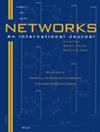Vertex covering with capacitated trees
IF 1.3
4区 计算机科学
Q4 COMPUTER SCIENCE, HARDWARE & ARCHITECTURE
引用次数: 1
Abstract
The covering of a graph with (possibly disjoint) connected subgraphs is a fundamental problem in graph theory. In this paper, we study a version to cover a graph's vertices by connected subgraphs subject to lower and upper weight bounds, and propose a column generation approach to dynamically generate feasible and promising subgraphs. Our focus is on the solution of the pricing problem which turns out to be a variant of the NP‐hard Maximum Weight Connected Subgraph Problem. We compare different formulations to handle connectivity, and find that a single‐commodity flow formulation performs best. This is notable since the respective literature seems to have widely dismissed this formulation. We improve it to a new coarse‐to‐fine flow formulation that is theoretically and computationally superior, especially for large instances with many vertices of degree 2 like highway networks, where it provides a speed‐up factor of 5 over the non‐flow‐based formulations. We also propose a preprocessing method that exploits a median property of weight‐constrained subgraphs, a primal heuristic, and a local search heuristic. In an extensive computational study we evaluate the presented connectivity formulations on different classes of instances, and demonstrate the effectiveness of the proposed enhancements. Their speed‐ups essentially multiply to an overall factor of well over 10. Overall, our approach allows the reliable solution of instances with several hundreds of vertices in a few minutes. These findings are further corroborated in a comparison to existing districting models on a set of test instances from the literature.顶点覆盖有能力树
用(可能不相交的)连通子图覆盖图是图论中的一个基本问题。在本文中,我们研究了一种用受上下权值约束的连通子图覆盖图的顶点的版本,并提出了一种列生成方法来动态生成可行且有前景的子图。我们的重点是定价问题的解决方案,该问题是NP-hard最大权连通子图问题的一个变体。我们比较了不同的配方来处理连通性,发现单一商品流配方表现最好。这一点值得注意,因为相关文献似乎普遍否定了这一提法。我们将其改进为一种新的从粗到细的流量公式,该公式在理论和计算上都很优越,尤其是对于具有许多2级顶点的大型实例,如公路网,它比基于非流量的公式提供了5的加速因子。我们还提出了一种预处理方法,该方法利用了权重约束子图的中值性质、原始启发式和局部搜索启发式。在一项广泛的计算研究中,我们在不同类别的实例上评估了所提出的连通性公式,并证明了所提出增强的有效性。他们的速度基本上是10倍以上。总的来说,我们的方法允许在几分钟内可靠地解决具有数百个顶点的实例。这些发现在与文献中一组测试实例的现有分区模型的比较中得到了进一步的证实。
本文章由计算机程序翻译,如有差异,请以英文原文为准。
求助全文
约1分钟内获得全文
求助全文
来源期刊

Networks
工程技术-计算机:硬件
CiteScore
4.40
自引率
9.50%
发文量
46
审稿时长
12 months
期刊介绍:
Network problems are pervasive in our modern technological society, as witnessed by our reliance on physical networks that provide power, communication, and transportation. As well, a number of processes can be modeled using logical networks, as in the scheduling of interdependent tasks, the dating of archaeological artifacts, or the compilation of subroutines comprising a large computer program. Networks provide a common framework for posing and studying problems that often have wider applicability than their originating context.
The goal of this journal is to provide a central forum for the distribution of timely information about network problems, their design and mathematical analysis, as well as efficient algorithms for carrying out optimization on networks. The nonstandard modeling of diverse processes using networks and network concepts is also of interest. Consequently, the disciplines that are useful in studying networks are varied, including applied mathematics, operations research, computer science, discrete mathematics, and economics.
Networks publishes material on the analytic modeling of problems using networks, the mathematical analysis of network problems, the design of computationally efficient network algorithms, and innovative case studies of successful network applications. We do not typically publish works that fall in the realm of pure graph theory (without significant algorithmic and modeling contributions) or papers that deal with engineering aspects of network design. Since the audience for this journal is then necessarily broad, articles that impact multiple application areas or that creatively use new or existing methodologies are especially appropriate. We seek to publish original, well-written research papers that make a substantive contribution to the knowledge base. In addition, tutorial and survey articles are welcomed. All manuscripts are carefully refereed.
 求助内容:
求助内容: 应助结果提醒方式:
应助结果提醒方式:


